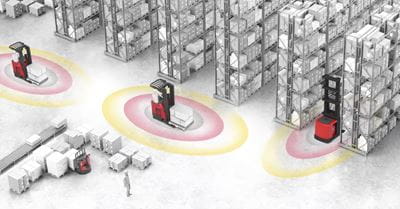Enhancing Warehouse Safety and Efficiency with iWAREHOUSE ObjectSense Detection and Notification Systems

The iWAREHOUSE ObjectSense Detection and Notification System enhances warehouse safety by using lidar-scanning technology to adapt detection fields based on forklift speed and steer angle, reducing collision risks. By integrating real-time data and analytics, it not only prevents accidents but also provides actionable insights for optimizing training, maintenance, and traffic flow.
In the frenetic environment of modern warehouses, where forklifts slip through narrow aisles and pedestrians navigate around heavy machinery, the margin for error is perilously thin. A single collision can cascade into lost productivity, damaged goods, or most critically, worker injuries. Enter the iWAREHOUSE ObjectSense Detection and Notification System, a technological advancement designed to address these challenges head-on. By integrating adaptive sensor technology with real-time operator feedback, this system redefines how warehouses balance safety and efficiency. At its core, the iWAREHOUSE ObjectSense system functions as a vigilant co-pilot for forklift operators. Using lidar-scanning technology, a method similar to radar but with laser precision, it creates a dynamic detection field around the vehicle. Unlike static proximity sensors, this field adapts in real time to two critical variables: Speed: As a forklift accelerates, the detection range extends farther ahead, granting operators more reaction time. Conversely, at slower speeds, the field narrows to focus on immediate obstacles. Steer Angle: When navigating tight corners or curved aisles, the sensing field reshapes itself to match the truck’s turning radius, eliminating blind spots. These adjustments occur seamlessly, ensuring protection whether the vehicle is traveling forks-first in narrow aisles or reversing through congested dock areas. When an object enters the detection zone, the system triggers a hierarchy of responses: an audible alarm, a flashing visual alert, and eventually an automatic slowdown or stop. This layered approach ensures operators retain control while mitigating collision risks. While preventing accidents is its first priority, ObjectSense’s value extends into operational analytics. Every slowdown, stop, or near-miss event is logged and categorized by operator, vehicle type, and facility zone. These datasets feed into the iWAREHOUSE GATEWAY platform, where managers can identify patterns such as: Recurring bottlenecks in specific warehouse sections Operators who may benefit from additional training Equipment models prone to frequent interventions. For example, a spike in alerts near loading docks might prompt a redesign of traffic flow, while repeated incidents involving a specific forklift could indicate maintenance needs. By transforming raw data into actionable insights, ObjectSense shifts safety management from reactive to proactive—a critical advantage in industries with high employee turnover or seasonal workers. One of ObjectSense’s most compelling features is its compatibility with both new and existing Raymond forklifts. For facilities upgrading their fleets, the system comes factory-installed on models like Reach-Fork trucks, Swing-Reach turret trucks, and rider pallet trucks. For those retaining older equipment, retrofit kits enable seamless integration without costly infrastructure changes. Customization further enhances adaptability. Facility managers can adjust parameters such as: Detection sensitivity for different zones (e.g., high-traffic vs. storage areas) Response protocols (audible warnings only vs. enforced stops) Speed thresholds for automatic deceleration. This flexibility ensures the system aligns with unique operational workflows, whether in a frozen food warehouse requiring rapid stops on slick floors or an e-commerce hub prioritizing uninterrupted throughput. Warehouse managers often grapple with the dual challenges of training new operators and combating complacency among seasoned staff. ObjectSense addresses both by serving as a real-time coaching tool. Novices receive immediate feedback when approaching obstacles too quickly, reinforcing safe speeds and spatial awareness. Veteran operators, meanwhile, benefit from subtle nudges that prevent lapses in focus during long shifts, a common cause of accidents. The system’s reporting features also streamline training evaluations. Instead of relying on periodic assessments, supervisors can review objective data on individual performance, tailoring coaching to specific weaknesses like cornering techniques or load visibility. This data-driven approach mirrors trends in workforce management, where wearable tech and IoT devices personalize skill development. ObjectSense doesn’t operate in isolation. When paired with other iWAREHOUSE solutions, such as fleet telematics or virtual reality simulators, it becomes part of a holistic safety network. Consider these synergies: Predictive Maintenance: Data on frequent braking events could trigger early inspections of brake systems. VR Training: Operators who struggle with specific detection scenarios in real life can rehearse them in a risk-free virtual environment. Energy Management: Slower, more controlled movements may reduce battery consumption in electric forklifts, aligning with sustainability goals. This interoperability positions ObjectSense as a bridge between today’s manual operations and tomorrow’s fully automated warehouses, where autonomous forklifts will rely on similar sensor arrays. While the moral imperative for worker safety is clear, ObjectSense also delivers measurable ROI: Accident Reduction: Early adopters report up to a 60% decrease in collision-related incidents, slashing costs tied to equipment repairs, medical claims, and downtime. Productivity Gains: By preventing abrupt stops and optimizing travel paths, facilities maintain throughput even with safety interventions. Training Efficiency: Targeted coaching based on system data reduces onboarding time for new hires by an average of 30%. For a mid-sized distribution center operating 50 forklifts, these savings can justify the system’s implementation within 12–18 months—a compelling case for CFOs and risk managers alike. The iWAREHOUSE ObjectSense Detection and Notification System transcends the role of a mere safety device. It is a dynamic ally that adapts to both machine and human behaviors, fostering a culture of vigilance without sacrificing efficiency. For warehouse operators navigating the complexities of modern logistics, adopting this technology isn’t just about avoiding accidents—it’s about future-proofing operations in an era where speed, safety, and data are inextricably linked. To learn more about ObjectSense and the entire suite of iWarehouse solutions, talk to a warehouse expert at Raymond West today.
The Invisible Guardian: How ObjectSense Operates
Beyond Alerts: Data-Driven Insights for Continuous Improvement
Flexibility Across Fleets: Retrofitting and Customization
The Human Factor: Reinforcing Training and Reducing Fatigue
Integration with the Smart Warehouse Ecosystem
The Bottom Line: Quantifying Impact
Raymond: A New Standard for Material Handling

